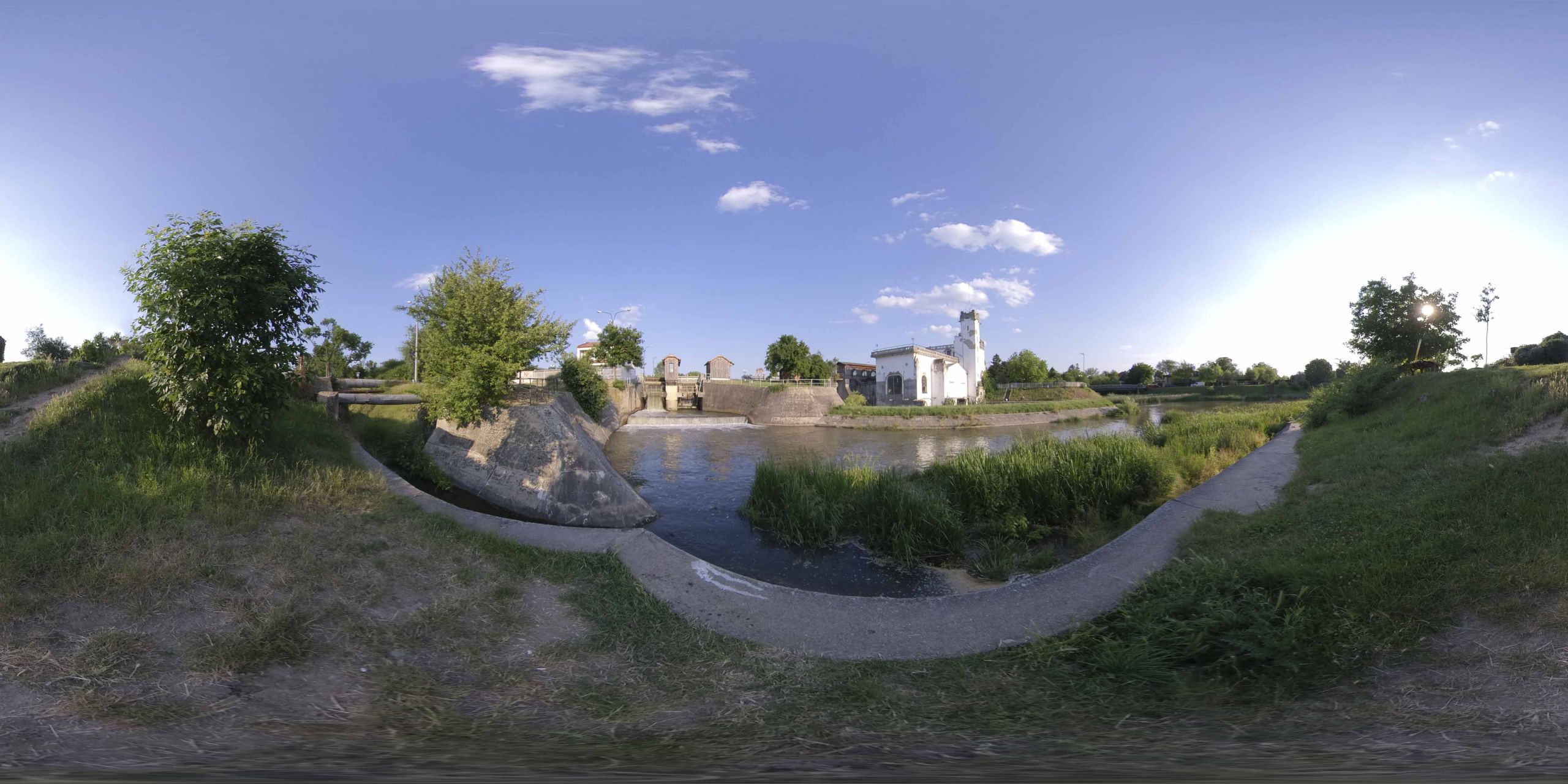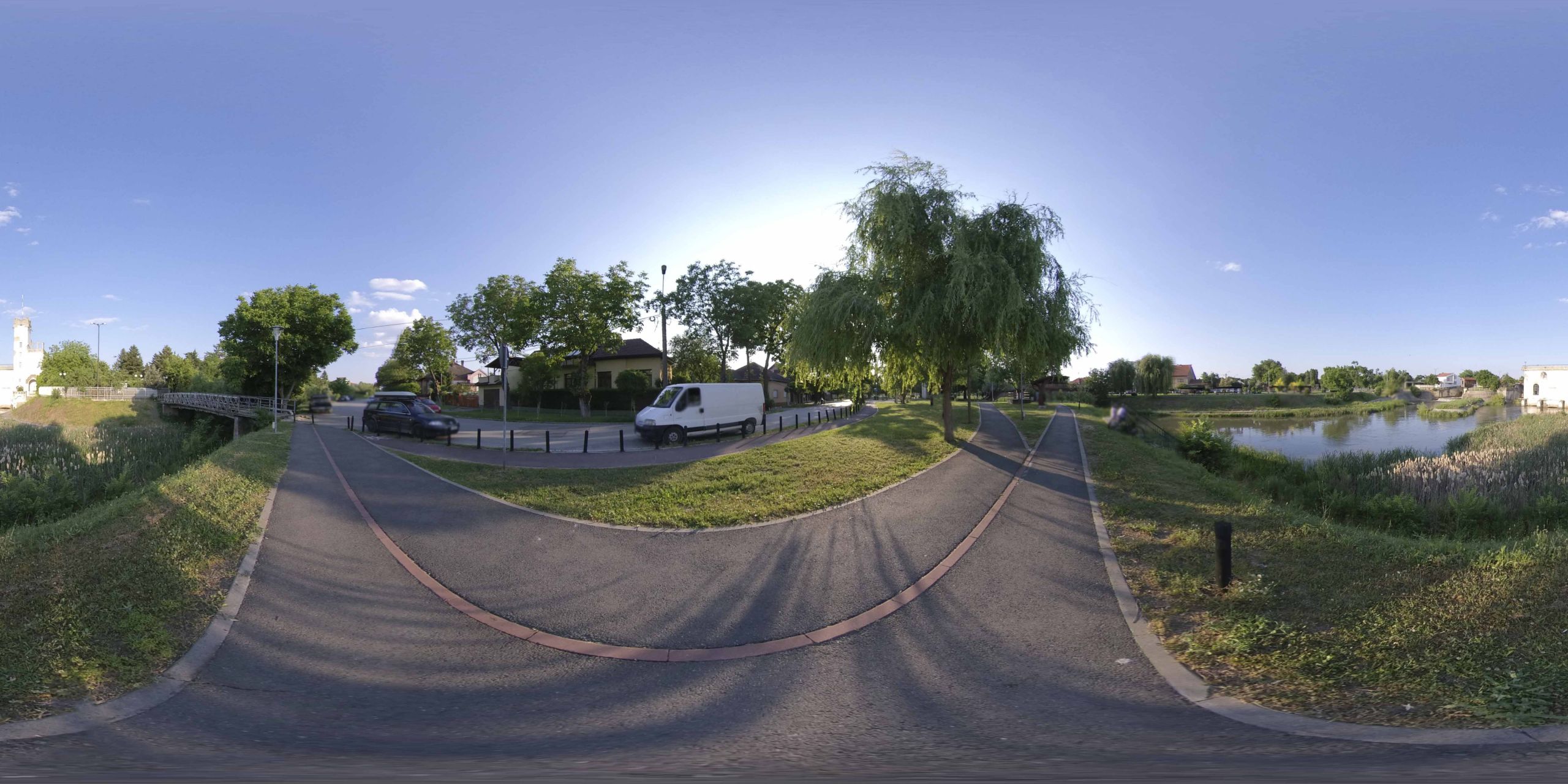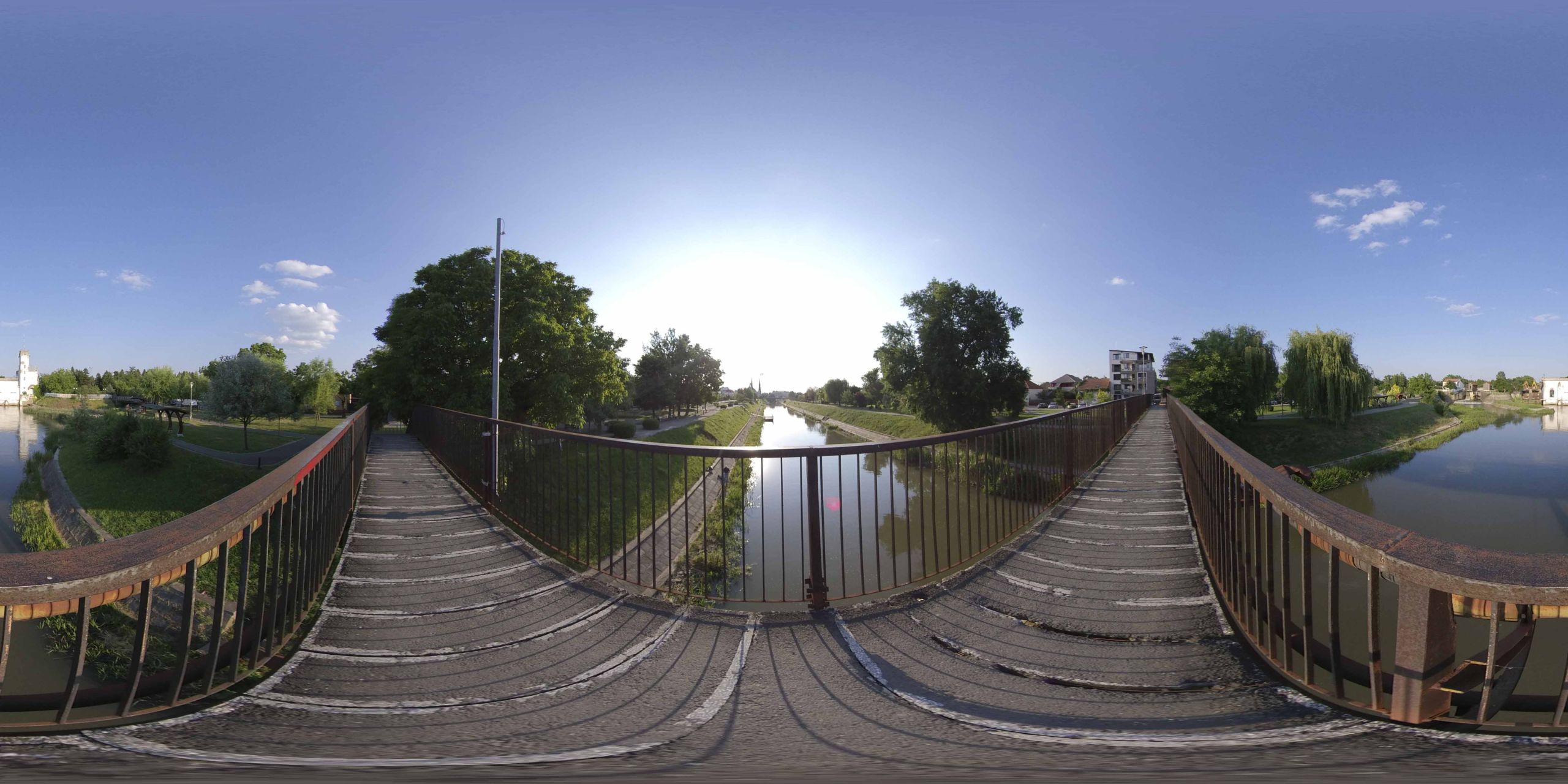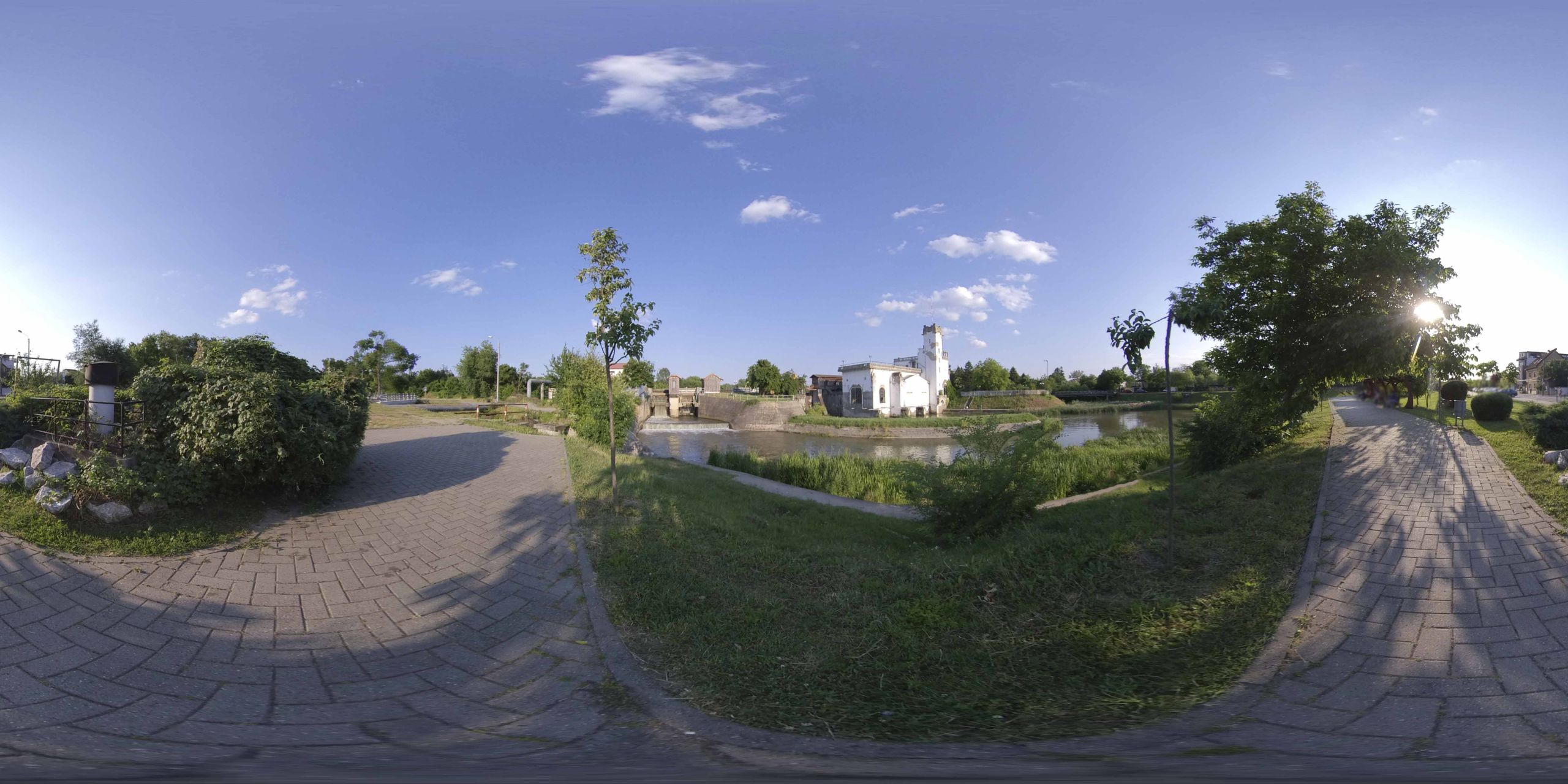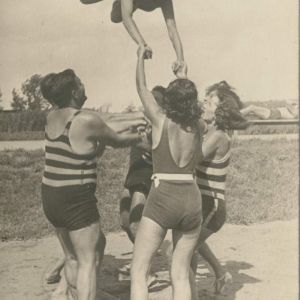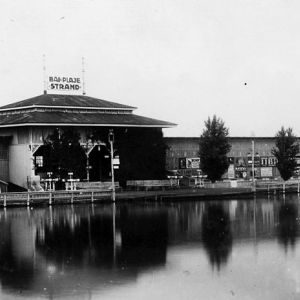Waterworks, 1 Uzinei Street
The first projects, which aimed at the profitable use of the hydraulic power of Bega, were taken into account when the Technical Service elaborated the systematization plan of the city.
Listen to the audio version.
The first projects, aimed at profitably using the hydraulic power of Bega, did not take into account the systematization of the city. However, these initiatives were taken into account when the Technical Service drew up the city's systematization plan. Engineer Emil Szilárd, who became head of the department in 1903, played an important role in drawing up the Bega regularization project. Drawing on the experience gained as a collaborator during the construction of the Ikervár hydropower plant, he made an important contribution to the process of building The Hydroelectric Power Station.
The hydraulic power was to be concentrated in one place, in order to provide more energy, which could be used by the mills, institutions, and lighting of the city. According to this plan, Bega was to cross the Fabric, downstream of the turbine mentioned above, in a single riverbed, formed by the union of the mills' channel and the floating channel, the other channels going to be covered. The project was materialized in 1907, after the redemption of the rights to use the water on the upper Bega and on the Suboleasa canal, as well as on the chamber wood depot.
The entire work was completed in 1910, the electricity produced by the Plant's turbines contributing to a substantial coal economy and a significant profit. Thanks to the regularization works of Bega, the sanitary conditions in the Fabric neighborhood have improved and the groundwater level has decreased significantly. In addition, the works made it possible to expand the Fabric neighborhood to the Cetate neighborhood and made the Bega navigable throughout the city.
The hydropower building is a unique element in the landscape of industrial architecture in Timișoara. It was designed by one of the city's leading architects, László Székely, in the secessionstyle. It is an ensemble classified as a historical monument, and consists of an elevated body, resembling a tower, a building on the left bank of the Bega, and a building that stretches above the water. Behind the ensemble where the accumulation lake was arranged, Baia and Plaja Populară functioned for almost 50 years.
Bibliography:
Josef Geml, The old Timișoara in the last half of the century 1870-1920, Cosmopolitan Art Publishing House, Timișoara, 2016.
The Hydroelectric Power Station
It was very nice there, near the hydroelectric power station on the Bega river, on the end side of the Fabric district. There was a micro power station with a waterfall, but next to it, there was this wonderful bathing place. There hasn’t been anything like that in Timişoara ever since. There were wooden changing cabins made of planks, two two-storey buildings, where you could leave your clothes. There were attendants who gave you the key, with a number, and there was no stealing because if you locked your cabin and gave the key to the attendant at a counter, they would hang it on a key rack like in a hotel and there it was. The showers were at the end of both buildings, and in the middle, there was a large restaurant, a buffet restaurant, a barber’s shop, a sweet shop. Then there were two other buildings, but not with cabins, with lockers. It was like a public cabin where you could put your clothes in a locker. There were also two large separate areas for nudists. It was a huge bathing complex, but it was abandoned after the war.
Vladimir Nenadovici, born in 1923 in Timișoara - excerpt from an interview by Adrian Onică, Timișoara 2003, The oral history and anthropology group archive, coordinated by Smaranda Vultur.
This bathing place was on the banks of river Bega, behind the dam. This was the largest bathing place, very well maintained, it was the riverbank on the side of the city, not of Vlaşca Mala. It was very neat. The sand was raked every morning. They had many employees, but people didn’t litter the beach. If, by any chance, there was a piece of paper on the ground, the staff would pick it up at once. It was very clean. We bathed in the Bega river. The water was clean, I suppose, back then. It wasn’t. It’s a river, it’s muddy. Bega river is not muddy when the water is very cold and the mud goes to the bottom, that is, in winter. But when the water is warm, the Brownian motion brings the mud to the surface and so it was muddy. There were showers and you would take a shower every time you got out of the water.
Mihai Şora, born in 1916 in Ianova, Timiș – excerpt from an interview by Smaranda Vultur, Băile Herculane 2001, The oral history and anthropology group archive, coordinated by Smaranda Vultur.
Crişan neighbourhood was set up in 1924... named after Crişan Nicolae. He owned the whole area and then he parceled it out and sold it. The people here didn’t own land, they were all workers from the city or from other places. At first, each of them built a hut and later they built bigger houses. Back then, there were no cobbled or paved streets, only mud. They would only buy wood in the summer, when it was dry and the cart could move around, because if you bought it in winter, they would leave it on the ground at the limit of the neighbourhood and you had to use a wheelbarrow or a sack to carry it home. Many Hungarians lived here in Crişan, many more than now, Germans, Romanians, a few Serbs, one or two Jews. There was a family on this street who ate nothing but nuts and apples and the like. That’s what they lived on and their daughter didn’t make it, she got sick and died. The old lady was the last to go, she was called Ler-néni. She would always go bathing in the summer with a kind of swim ring to hold her above the water. She would go bathing with a cane and all that, poor thing. And there were many young people here, very many at that time... For fun, there was Dinu-baci’s pub, with a big dance floor, there was Fogli’s pub and at the corner there was another pub, Roman’s, which later on became the Town Hall. Well then, young people would go there. The local orchestra consisted of the three Müller boys. They were German and went to war as German soldiers. Loizi, the hunchback, was a fiddler and he also played the tambourine, Gheza played the banjo and Feri, the guitar. Then came Sücs-baci with the tambourine and some other drummer, also Körösi-baci with the saxophone. And it was fun. Every year, on July 15 we had this kermess, called Kirvai or Buciu, and then, on August 15 there was another one, the Romanian Ruga. Every Sunday night there was a dance, sometimes a ball: the Chocolate Ball, the Grape Harvest Ball, the Recruit’s Ball. For Kirvai there was a ball, also on different holidays: Christmas, Easter, Pentecost ... all the time.
Sipos Péter, born in 1925 – excerpt from an interview by Antonia Komlosi, Timișoara 2003, The oral history and anthropology group archive, coordinated by Smaranda Vultur.
Where did you go to swim? To Bega. To the big pool, but not the one that's there now, modern and horrible, it was... So, if you went by tram number one, you would arrive in front of the Romanian Parish of Fabric, where Şorii lived, right? I mean my future parents-in-law, whom I didn't know at the time, and the tram took it, before the bridge, to the right, towards the Power Plant. It turned the corner and went all the way to the Power Plant. That's where End Station was, everyone downstairs. And that's where we were waiting for it. Number one. From there to the train station.
And this was a five hundred meters long swimming pool, with benches, with gymnastic equipment, with wonderful sand on the ground, with dirty water... ...awful! I once saw a dead pig floating, from the villages... Later, when we were students and I was flirting with Mihai Șora, then we would take the boat and go to the first village, Remetea or which... we would go by boat there and the mosquitoes would eat us to death, and we would talk about Proust and I don't know what... I read Proust more there than at home.
But the swimming pool from Timișoara was and is a legend. I used to go with my parents at the beginning, as I was saying, my father was a good swimmer, and they tied me to the rope to teach me. And I learned, according to the rule. And after the sixth or seventh lesson, he told me: Try it by yourself. And that was it. So, you could swim in Bega. In the Bega. And I swallowed some of that crap. And I swallowed especially when I jumped off the springboard! Jumping on my head. And, oh, I was very boyish. And I tell you, we used to fight with the boys, and there were some boys from Loga, very nice and very athletic. And there I left in my memory the swimming pool and the other one, called the big swimming pool... I’ve been there too, maybe fifteen years ago, but no... And I don't want to forget that one... Do you think it was someone's property? Who was setting it up? I think the city owned it. I don't see why it would be privately owned, the city was administrating it. Did it have any terraces? It had... So, on the other side there were some bathrooms and a cabin - two for the solarium, where you could completely undress, because it wasn't as fashionable as now, to show everything. And on the other side there was a row of cabins, which you climbed up to, so the cabins were a little bit elevated above the ground itself, below, and in the middle, there was a... like a little market, let's say, a big, big kiosk, like a stall, where you could go inside and buy bread with butter and peppers. Bread as thick as four of my fingers now and butter as thick as a finger on it and with a slice or two of a green bell pepper that was crunchy and fragrant, and you'd bite from it... it was something... You didn't go for Coke or Pepsi or any of that crap, you drank water. That was a trend.
Mariana Șora, born Klein, in 1917 in Timișoara - excerpt from the interview conducted by Smaranda Vultur in Baile Herculane in 2001, The oral history and anthropology group archive, coordinated by Smaranda Vultur.
From the Hydroelectric Power Station to the Plopi district
(...) "Today I made up for the loss by walking through the east of Timișoara, where once the poplars lined the shore of the Bega River.
Low land, originally situated outside the town, used for a long time, in the middle of the 18th century, for the rice fields of the fortress. When it was owned by Malva, the widow of Count Ladislau Gyurky, the settlement was called Kardos-telep. After the First World War, the land was sold to a modest population of Hungarian and German craftsmen, and the settlement slowly grew closer to the town and became a district from it. Romul Ladea lived here for a while in the ‘40s. In love with the water-guardian trees, Ladea imposed the new name of the neighborhood, Plopi.
The building of the Hydroelectric Power Station, which dominates the Bega, dating from 1910, was designed by Székely Laszlo, chief architect of Timișoara, becoming one of the effigies of Timișoara's industrial architecture. Equipped with three Ganz Danubius turbines brought from Budapest, it still produces electricity for the city.
I revisited the neighbourhood today, with which, on several occasions, my life has intersected. The Zürich Street of my childhood and adolescence was attached to the line of tram 2. Below it, the adventure began. Those who ventured towards Plopi were only the fearless ones. By the ’70s, only the "cool" boys of the city played in Plopi. The meeting point was the Hydroelectric Power Station. They would come with their bikes, carrying a brave girl on their handlebars, red in the cheeks of emotion for adventure. They swam to the Prințul Turcesc bridge. In the evening, after filling a few cigarette leaves with shredded tobacco, they would ride back to the city in a group with their bicycles. Later, when the town's rowing club appeared, the exercises were also held here. At the Turbine and the Power Station were the places with a touch of daring that marked a generation with a taste for risk. Kelemen Pista, Szekeres Gabi, Cuci are among those who have preserved the ancestry of their youth spent in Plopi.
Years later, when I became a teacher, the surprise was to return to the neighbourhood, to the school on Moise Nicoară, which stretched all the way to Bega, near the bridge at Prințul Turcesc. I walked the streets of the area, doing, as form teacher, the "home visits" recommended by the communist education. I recognized the streets by the sounds that re-echoed in my memory, but the world had changed. On Dorobantilor, at the tram line, the new inhabitants of the neighbourhood had appeared, the gypsies, for whom school was an optional obligation. But the Ghirodei road, which went deep into Plopi, remained the same: populated by modest, mixed people, who no longer had their workshops at home, but were workers in the city factories: Electrotimiș, UMT, 6 Martie... Small, neat houses, crowded together in courtyards that divided their functions between the vanished workshop, the vegetable garden, the wood storage and the children's common playground, the yard with chickens and geese raised for Sunday lunch. "
Sorina Jecza 5 December 2015
It was very nice there, near the hydroelectric power station on the Bega river, on the end side of the Fabric district. There was a micro power station with a waterfall, but next to it, there was this wonderful bathing place. There hasn’t been anything like that in Timişoara ever since. There were wooden changing cabins made of planks, two two-storey buildings, where you could leave your clothes. There were attendants who gave you the key, with a number, and there was no stealing because if you locked your cabin and gave the key to the attendant at a counter, they would hang it on a key rack like in a hotel and there it was. The showers were at the end of both buildings, and in the middle, there was a large restaurant, a buffet restaurant, a barber’s shop, a sweet shop. Then there were two other buildings, but not with cabins, with lockers. It was like a public cabin where you could put your clothes in a locker. There were also two large separate areas for nudists. It was a huge bathing complex, but it was abandoned after the war.
Vladimir Nenadovici, born in 1923 in Timișoara - excerpt from an interview by Adrian Onică, Timișoara 2003, The oral history and anthropology group archive, coordinated by Smaranda Vultur.
This bathing place was on the banks of river Bega, behind the dam. This was the largest bathing place, very well maintained, it was the riverbank on the side of the city, not of Vlaşca Mala. It was very neat. The sand was raked every morning. They had many employees, but people didn’t litter the beach. If, by any chance, there was a piece of paper on the ground, the staff would pick it up at once. It was very clean. We bathed in the Bega river. The water was clean, I suppose, back then. It wasn’t. It’s a river, it’s muddy. Bega river is not muddy when the water is very cold and the mud goes to the bottom, that is, in winter. But when the water is warm, the Brownian motion brings the mud to the surface and so it was muddy. There were showers and you would take a shower every time you got out of the water.
Mihai Șora, born in 1916 in Ianova, Timiș - excerpt from the interview conducted by Smaranda Vultur in Baile Herculane in 2001, The oral history and anthropology group archive, coordinated by Smaranda Vultur.
Crişan neighbourhood was set up in 1924... named after Crişan Nicolae. He owned the whole area and then he parceled it out and sold it. The people here didn’t own land, they were all workers from the city or from other places. At first, each of them built a hut and later they built bigger houses. Back then, there were no cobbled or paved streets, only mud. They would only buy wood in the summer, when it was dry and the cart could move around, because if you bought it in winter, they would leave it on the ground at the limit of the neighbourhood and you had to use a wheelbarrow or a sack to carry it home. Many Hungarians lived here in Crişan, many more than now, Germans, Romanians, a few Serbs, one or two Jews. There was a family on this street who ate nothing but nuts and apples and the like. That’s what they lived on and their daughter didn’t make it, she got sick and died. The old lady was the last to go, she was called Ler-néni. She would always go bathing in the summer with a kind of swim ring to hold her above the water. She would go bathing with a cane and all that, poor thing. And there were many young people here, very many at that time... For fun , there was Dinu-baci’s pub, with a big dance floor, there was Fogli’s pub and at the corner there was another pub, Roman’s, which later on became the Town Hall. Well then, young people would go there. The local orchestra consisted of the three Müller boys. They were German and went to war as German soldiers. Loizi, the hunchback, was a fiddler and he also played the tambourine, Gheza played the banjo and Feri, the guitar. Then came Sücs-baci with the tambourine and some other drummer, also Körösi-baci with the saxophone. And it was fun. Every year, on July 15 we had this kermess, called Kirvai or Buciu, and then, on August 15 there was another one, the Romanian Ruga. Every Sunday night there was a dance, sometimes a ball: the Chocolate Ball, the Grape Harvest Ball, the Recruit’s Ball. For Kirvai there was a ball, also on different holidays: Christmas, Easter, Pentecost ... all the time.
Sipos Péter, born in 1925 – excerpt from an interview by Antonia Komlosi, Timișoara 2003, The oral history and anthropology group archive, coordinated by Smaranda Vultur.
